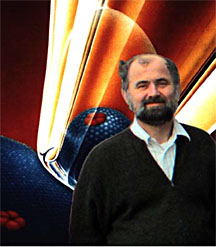Nobel Laureate Neher to present colloquium at Cornell, March 30
By David Brand

German scientist Erwin Neher, joint winner of the 1991 Nobel Prize in physiology or medicine, will present a special colloquium at Cornell University Friday, March 30. It will take place at 12:30 p.m. in Room G10 of the Biotechnology Building, and it is free and open to the public.
The colloquium, jointly sponsored by Cornell's School of Applied and Engineering Physics, the Department of Molecular Biology and Genetics and the graduate field of biophysics, is titled "Exploring the Functional Role of Synaptic Proteins With Rapid Techniques." It will be hosted by Manfred Lindau, Cornell associate professor of applied and engineering physics.
Neher won the Nobel Prize with Bert Sakmann of the Max-Planck-Institute for medical biology in Heidelberg, Germany, for discoveries concerning the function of single ion channels in cells.
Since 1983 Neher has been director of the membrane biophysics department at the Max-Planck-Institute for biophysical chemistry in Göttingen, Germany. He and Sakmann were awarded the Nobel for developing a technique that allows the registration of the incredibly small electrical currents that pass through a single ion channel. The technique is unique in that it records how a single-channel molecule alters its shape and, in that way, controls the flow of current across the membrane of a cell, within a time frame of a few millionths of a second.
Neher and Sakmann conclusively established with their technique that ion channels do exist and how they function. They demonstrated what happens during the opening or closure of an ion channel with a diameter corresponding to that of a single sodium or chloride ion. Many ion channels are regulated by a protein spanning the cell membrane that upon activation alters its shape and forms a transmembrane channel for inorganic ions. Neher and Sakmann showed which parts of the molecule constitute the "sensor" and the interior wall of the channel. They also showed how the channel regulates the passage of positively or negatively charged ions. This new analytical tool has revolutionized modern biology in the past two decades. It also has contributed to the understanding of how brain cells communicate and of the cellular mechanisms underlying several diseases, including diabetes and cystic fibrosis.
Neher's current research concentrates on pre-synaptic aspects of neural information flow.
Media Contact
Get Cornell news delivered right to your inbox.
Subscribe